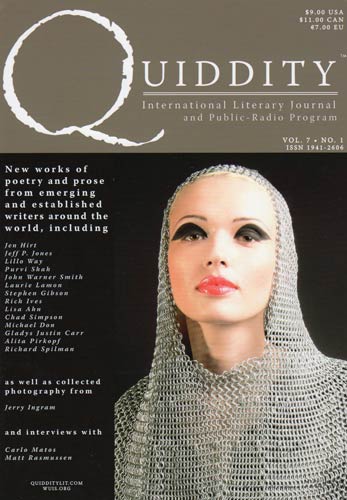Quiddity – Spring/Summer 2014
This Spring/Summer 2014 issue of Quiddity is ambrosia to modern writers and readers alike. It values brevity, and wraps life’s enigmas in eloquent vocabulary. Three-quarters of the issue is dedicated exclusively to poetry, but even the prose is concise, and yet all of the pieces are dense with dimension and meaning. This issue is broken into four categories: poetry, prose, interviews, and art. Each section is carefully pieced together like patches to create a beautiful quilt.
This Spring/Summer 2014 issue of Quiddity is ambrosia to modern writers and readers alike. It values brevity, and wraps life’s enigmas in eloquent vocabulary. Three-quarters of the issue is dedicated exclusively to poetry, but even the prose is concise, and yet all of the pieces are dense with dimension and meaning. This issue is broken into four categories: poetry, prose, interviews, and art. Each section is carefully pieced together like patches to create a beautiful quilt.
The poetry is artfully scattered throughout the magazine and some of the pieces chosen are just breathtaking. One of the best poems is entitled “In the Browsing Room, Elaine” by Oliver Rice, and he speaks of the wonders and pains of history:
Victims of Stalin cry out, Elaine,
without wit or compassion
to the trifling and the curious.
Beneath them the continents drift.
In the industrial haze,
Crusaders loot, Heidelberg women weep.
Insects copulate at the crossroads
where Oedipus slew his father.
Rice captures the beauty and the horror of real events and brings them to the forefront of our mind to remember what is left when we realize what has been lost.
In “Sheep is a Tonal Language,” Candace Black reminisces on the importance of a strange encounter with a sheep:
[. . .]Days earlier, in Shetland,
I’d passed a solitary lamb, dried umbilicus
clinging to its abdomen, bleating with the same insistence
of a newborn I recognize—want to respond to—wherever
I am. Maa! If I’d been thirty years younger
my milk would’ve let down
Black recognizes an unseen force of empathy that lives in every living thing, and in this piece, her body responds in a visceral way to the bleating of a newborn lamb. Black has a way of verbalizing this primal reaction (a yearning, of sorts) to connect with the life around us, and allows us to see past physical limitations and tap into this unseen force of the Cosmos.
The prose here is equally as impressive. “Holiness Week” by Alison Wisdom is a short story about a polygamous religious sect from Texas, and is written from the perspective of a young woman inside the sect. The sentences are moving and poetic, such as: “His [the Prophet’s] little birds carry back messages of obedience and waywardness, secrets clutched in their little bird claws” and “[t]he twins will be forced. . . to take it to the chapel where they will nail their sin to the oversized cross that presides over the room. . . there will be other paraphilia attached to the cross.” The characters come to life on the pages and allow for an outsider to observe a world beyond their own boundaries. Jeff P. Jones does this as well in his short story entitled “Dear Anastasia” where, after an epiphany, he understands his complex feelings for his country. “It’s not that I stopped loving America. . . I began loving it in a different way. . . as a work-in-progress. . . I allowed myself to hate my country for its excesses and to love it for its potential.” This political work is based on a letter written for his child, Ana, after being imprisoned. This piece is touching, politically taboo, highly intellectual, and a pleasure to read.
The interviewees of this issue are Matt Rasmussen and Carlo Matos, and both are very distinguished poets. Minnesotan Matt Rasmussen’s poetry revolves around suicide; his brother committed suicide when he was sixteen. Rasmussen discusses how his life and art were shaped around this terrible event. Carlo Matos is a professor of writing at the City Colleges of Chicago and writes about the obstacle of speaking English as a second language in the U.S.
There is one featured artist in this issue of Quiddity, and it is the very talented Jerry Ingram. His photography is displayed inside the magazine, as well as the art for the cover. His subjects take on a god-like quality as they are manipulated with props, light, or makeup. The two stand outs are the cover and a photo on page seventy. The cover is of a female mannequin head with a chainmail coif that screams beauty and strength, going against gender norms. The inside photo is of a woman in a black dress, white chalk smeared over her skin, wearing a fencing mask. These two photos complement each other while at the same time appear to be polar opposites, but both capture the vulnerable mystery of the female form.
Quiddity is able to verbalize and personify the strongest, and strangest, of emotions and observations. The pieces selected were insightful, politically charged, and reached toward the entire range of human feelings. This issue was a pleasure to read, and I recommend it to anyone who desires truth in their art.
[www.quidditylit.com]
Reviewer bio: Sarah Waldowski is pursuing a M.A. of Writing at Coastal Carolina University, where she is also an editorial assistant for Waccamaw literary journal. She lives in Conway, S.C.





